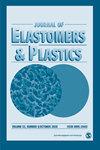大豆蛋白/碳水化合物比在苯乙烯-丁二烯聚合物中的增强作用
IF 1.6
4区 材料科学
Q4 MATERIALS SCIENCE, MULTIDISCIPLINARY
引用次数: 8
摘要
将大豆蛋白和碳水化合物按不同比例与乳胶共混制成复合材料。蛋白碳水化合物比的变化对复合材料的性能有显著影响,动态力学方法的结果显示出明显的增强效应。蛋白质含量高的填料增强复合材料的模量高于碳水化合物含量高的复合材料。与大豆蛋白相比,大豆碳水化合物似乎也具有固定聚合物链的能力。疲劳试验表明,在动态应变循环反复应力作用下,蛋白质含量较高的复合材料比碳水化合物含量较高的复合材料具有更强的弹性。恢复实验表明,复合材料的模量越高,变形后的长时间恢复效果越好。应力-软化循环后的平衡残余结构分析表明,高蛋白质含量复合材料在施加更大应变之前具有弹性而不屈服,而高碳水化合物含量复合材料的结构随着应变大小的增加而持续屈服。综上所述,具有较高蛋白质/碳水化合物比的大豆填料具有作为橡胶补强剂的潜力。本文章由计算机程序翻译,如有差异,请以英文原文为准。
Reinforcement Effect of Soy Protein/Carbohydrate Ratio in Styrene—Butadiene Polymer
Soy protein and carbohydrate at different ratios were blended with latex to form composites. The variation of protein-to-carbohydrate ratio has a significant effect on the composite properties, and the results from dynamic mechanical method showed a substantial reinforcement effect. The composites reinforced by the filler with higher protein content had higher moduli than the composites with higher carbohydrate content. Soy carbohydrate also appeared to have ability to immobilize polymer chains compared to soy protein. The fatigue experiments showed that the composites with higher protein content were more elastic than the composites with higher carbohydrate content after repeatedly stressed with dynamic strain cycles. The recovery experiments showed that the moduli of the composites with higher protein content had better long-time recovery after deformation. The analysis of equilibrated residual structure after the stress-softening cycles showed that the composites with higher protein content were resilient without yielding until a larger strain was applied, while the composites with higher carbohydrate content had a continuous yielding in their structures as the magnitude of the strain was increased. Overall, the study shows that soy fillers with higher protein/carbohydrate ratio have potential to be used as rubber reinforcement.
求助全文
通过发布文献求助,成功后即可免费获取论文全文。
去求助
来源期刊

Journal of Elastomers and Plastics
工程技术-材料科学:综合
CiteScore
3.30
自引率
5.90%
发文量
41
审稿时长
6 months
期刊介绍:
The Journal of Elastomers and Plastics is a high quality peer-reviewed journal which publishes original research on the development and marketing of elastomers and plastics and the area in between where the characteristics of both extremes are apparent. The journal covers: advances in chemistry, processing, properties and applications; new information on thermoplastic elastomers, reinforced elastomers, natural rubbers, blends and alloys, and fillers and additives.
 求助内容:
求助内容: 应助结果提醒方式:
应助结果提醒方式:


